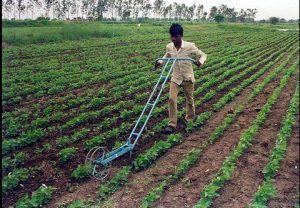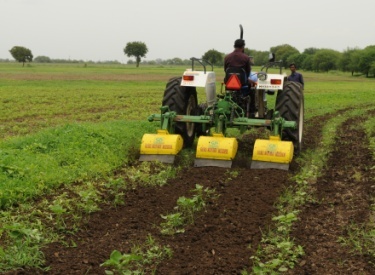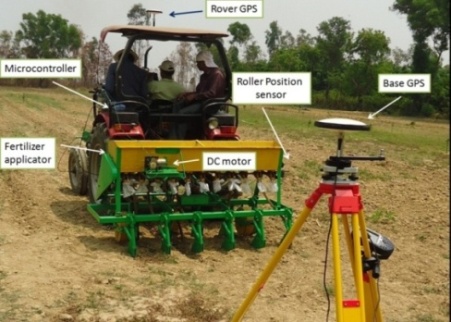Wheel Hoe

It is a manually operated long handle push-pull type tool and widely used for weeding and interculture in row crops. The number of wheels varies from one to two and the diameter depends upon the design. The frame has got a provision to accommodate different types of soil working tools such as straight blades, reversible blades, sweeps, V-blade, tine cultivator, miniature furrower, spike harrow (rake) etc. The handle assembly has a provision to adjust the height of the handle to suit the operator. For operation, the working depth of the tool and handle height are adjusted. It covers 0.10 ha/day. It costs Rs. 800/- and cost of operation is Rs 2000/ha.
Cono Weeder
 The cono weeder is used to remove weeds between rows of paddy crop. The weeder consists of two rotors, float, frame and handle. The rotors are cone frustum in shape, smooth and serrated strips are welded on the surface along its length. The rotors are mounted in tandem with opposite orientation. The orientation of rotors creates a back and forth movement in the top 30 mm of soil. The float, rotors and handle are joined to the frame. The float controls working depth and does not allow rotor assembly to sink in the puddle. The push-pull operation of cono weeder in between rows makes weeding effective. It costs Rs. 1900/- and field capacity is 0.18 ha/day.
The cono weeder is used to remove weeds between rows of paddy crop. The weeder consists of two rotors, float, frame and handle. The rotors are cone frustum in shape, smooth and serrated strips are welded on the surface along its length. The rotors are mounted in tandem with opposite orientation. The orientation of rotors creates a back and forth movement in the top 30 mm of soil. The float, rotors and handle are joined to the frame. The float controls working depth and does not allow rotor assembly to sink in the puddle. The push-pull operation of cono weeder in between rows makes weeding effective. It costs Rs. 1900/- and field capacity is 0.18 ha/day.
Self-propelled Power Weeder
 The machine is useful in row crops, horticultural and vegetable crops for weeding and seedbed preparation. It consists of a 4.1 kW diesel engine mounted on the power tiller chassis, power transmission system, two MS wheels, a frame and a rotary tiller. The power from the engine is transmitted to the rotary with the help of belt and chain and through gear train to the ground wheels. The rotary tiller has been provided with 16 blades fitted on high-pressure pipe of 37.5 mm diameter with the help of nuts and bolts to the flanges. For depth adjustment, two skids made of flat are provided on both sides of power tiller. A power cut-off device is provided to engage or disengage the power to the rotary system. The wheels with lugs are provided for traction. The speed of power weeder ranges 2.3-2.5 km/h with an effective working width of 550 mm giving field capacity of 0.10 to 0.13 ha/h. The cost of self-propelled power weeder is about Rs. 40,000 and average cost of weeding is Rs. 1000/ha. The equipment saves 90% operating time and 30% in cost of weeding as compared to hand weeding by khurpi.
The machine is useful in row crops, horticultural and vegetable crops for weeding and seedbed preparation. It consists of a 4.1 kW diesel engine mounted on the power tiller chassis, power transmission system, two MS wheels, a frame and a rotary tiller. The power from the engine is transmitted to the rotary with the help of belt and chain and through gear train to the ground wheels. The rotary tiller has been provided with 16 blades fitted on high-pressure pipe of 37.5 mm diameter with the help of nuts and bolts to the flanges. For depth adjustment, two skids made of flat are provided on both sides of power tiller. A power cut-off device is provided to engage or disengage the power to the rotary system. The wheels with lugs are provided for traction. The speed of power weeder ranges 2.3-2.5 km/h with an effective working width of 550 mm giving field capacity of 0.10 to 0.13 ha/h. The cost of self-propelled power weeder is about Rs. 40,000 and average cost of weeding is Rs. 1000/ha. The equipment saves 90% operating time and 30% in cost of weeding as compared to hand weeding by khurpi.
Power Weeder for Low Land Rice
 A two row power weeder has been developed at TNAU, Coimbatore in collaboration with M/s Premier Power Equipment & Product Pvt. Ltd., Coimbatore. It is suitable for doing timely weeding operation under all soil conditions in line sown and SRI paddy. It is a self-propelled, compact and light weight power weeder. It weighs 17 kg and consists of 1.30 kW engine, float and rotary cutting blades. There are four high speed rotating blades (300 rpm) on either side, which weed two rows at a time. The weeding width is 150 mm. Due to compactness and less weight, it is easily maneuverable between the crop rows at speed. The row spacing is 236 mm and hill spacing is 168 mm. The field capacity of the power weeder is 0.70 ha/day and is about 4 times higher than cono weeder. The average fuel consumption is 0.4 l/h. The commercial model of the weeder is being manufactured under the brand name Garuda.
A two row power weeder has been developed at TNAU, Coimbatore in collaboration with M/s Premier Power Equipment & Product Pvt. Ltd., Coimbatore. It is suitable for doing timely weeding operation under all soil conditions in line sown and SRI paddy. It is a self-propelled, compact and light weight power weeder. It weighs 17 kg and consists of 1.30 kW engine, float and rotary cutting blades. There are four high speed rotating blades (300 rpm) on either side, which weed two rows at a time. The weeding width is 150 mm. Due to compactness and less weight, it is easily maneuverable between the crop rows at speed. The row spacing is 236 mm and hill spacing is 168 mm. The field capacity of the power weeder is 0.70 ha/day and is about 4 times higher than cono weeder. The average fuel consumption is 0.4 l/h. The commercial model of the weeder is being manufactured under the brand name Garuda.
Tractor Mounted 3-Row Rotary Weeder
 A tractor mounted rotary weeder has been designed and developed at PAU, Ludhiana. It consists of a main frame, gearbox, three rotary weeding blade assemblies, a 40 mm square shaft for transmission of power from gearbox to rotary assemblies and a set of sprockets and chains. A standard 3-point hitch arrangement has been provided to mount the frame to tractor. Power from tractor PTO is transmitted to main square shaft through gearbox mounted on main frame and a set of sprockets and chain. It facilitates adjustment of row-to-row spacing from 675 to 1165 mm. The field capacity of machine is 0.24 ha/h with weeding efficiency of 83-87%.The approximate cost of this machine is Rs. 60,000/-. The cost of operation with the machine is Rs. 1700/ha for single weeding as compared to Rs. 3600/ha by manual weeding. The machine saves 54% labour and 74% cost of operation as compared to traditional method.
A tractor mounted rotary weeder has been designed and developed at PAU, Ludhiana. It consists of a main frame, gearbox, three rotary weeding blade assemblies, a 40 mm square shaft for transmission of power from gearbox to rotary assemblies and a set of sprockets and chains. A standard 3-point hitch arrangement has been provided to mount the frame to tractor. Power from tractor PTO is transmitted to main square shaft through gearbox mounted on main frame and a set of sprockets and chain. It facilitates adjustment of row-to-row spacing from 675 to 1165 mm. The field capacity of machine is 0.24 ha/h with weeding efficiency of 83-87%.The approximate cost of this machine is Rs. 60,000/-. The cost of operation with the machine is Rs. 1700/ha for single weeding as compared to Rs. 3600/ha by manual weeding. The machine saves 54% labour and 74% cost of operation as compared to traditional method.
Fertilizer Band Placement cum Earthing up Machine
 The tractor operated (26 kW and above) fertilizer band placement cum earthing up machine has been designed and developed at GBPUAT, Pantnagar. The machine is suitable for simultaneous placement of fertilizer, earthing up and cutting of weeds in crops such as maize, sugarcane, potato etc having more than 0.50 m row to row spacing. The urea fertilizer application rate ranges from 60 to 250 kg/ha. It helps in top dressing of fertilizer at 50 to 100 mm from the plant. The field capacity of machine is 0.56 ha/h with 82.4% field efficiency. The approximate cost of the machine is Rs. 50,000. There is considerable saving in fertilizer, time and labour over traditional method.
The tractor operated (26 kW and above) fertilizer band placement cum earthing up machine has been designed and developed at GBPUAT, Pantnagar. The machine is suitable for simultaneous placement of fertilizer, earthing up and cutting of weeds in crops such as maize, sugarcane, potato etc having more than 0.50 m row to row spacing. The urea fertilizer application rate ranges from 60 to 250 kg/ha. It helps in top dressing of fertilizer at 50 to 100 mm from the plant. The field capacity of machine is 0.56 ha/h with 82.4% field efficiency. The approximate cost of the machine is Rs. 50,000. There is considerable saving in fertilizer, time and labour over traditional method.
Tractor Operated Fertilizer Dibbler for Ratoon Sugarcane
 The field after harvest of sugarcane is covered by a mat of trash up to a depth of 150 mm and punch application enables placement of fertilizer through crop residue. A tractor operated fertilizer dibbler for ratoon sugarcane has been designed and developed at TNAU, Coimbatore for placement of fertilizer without much soil disturbance and through crop residue. The principal components of the implement are revolving spade, fertilizer metering device, fertilizer placement funnel, soil covering and pressing device. The cost of the unit is Rs. 45,000/- and field capacity is 0.2 ha/h. The cost of operation is Rs.1550/ha and results in saving of 60% as compared to the conventional method.
The field after harvest of sugarcane is covered by a mat of trash up to a depth of 150 mm and punch application enables placement of fertilizer through crop residue. A tractor operated fertilizer dibbler for ratoon sugarcane has been designed and developed at TNAU, Coimbatore for placement of fertilizer without much soil disturbance and through crop residue. The principal components of the implement are revolving spade, fertilizer metering device, fertilizer placement funnel, soil covering and pressing device. The cost of the unit is Rs. 45,000/- and field capacity is 0.2 ha/h. The cost of operation is Rs.1550/ha and results in saving of 60% as compared to the conventional method.
GPS Based Variable Rate Granular Fertilizer Applicator
 A GPS Based variable rate granular fertilizers (NPK) applicator has been developed at IIT Kharagpur and CIAE Bhopal to ensure ideal application of fertilizers as basal dose. It consists of a differential global positioning system (DGPS), micro-processor, micro-controller, DC motor actuator, power supply, threaded screw arrangement and fluted roller fitted metering mechanism. The fertilizer application rate is changed according to the prescribed application rate at the identified grid with coefficient of variation (CV) of 11.7-15.0%. The RMSE and relative differences (RD) at different levels of application rates ranged from 1.3 to 4.6 and from 1.75 to 6.56, respectively. The fertilizer application accuracy ranges from 89.3% to 98.1% at various discharge rates. It was observed that the developed variable rate fertilizer applicator (VRFA) was effective and accurate to respond to the target application rates with small delay of time. It was concluded that the developed VRFA system closely met the target fertilizer application rate at the selected grid.
A GPS Based variable rate granular fertilizers (NPK) applicator has been developed at IIT Kharagpur and CIAE Bhopal to ensure ideal application of fertilizers as basal dose. It consists of a differential global positioning system (DGPS), micro-processor, micro-controller, DC motor actuator, power supply, threaded screw arrangement and fluted roller fitted metering mechanism. The fertilizer application rate is changed according to the prescribed application rate at the identified grid with coefficient of variation (CV) of 11.7-15.0%. The RMSE and relative differences (RD) at different levels of application rates ranged from 1.3 to 4.6 and from 1.75 to 6.56, respectively. The fertilizer application accuracy ranges from 89.3% to 98.1% at various discharge rates. It was observed that the developed variable rate fertilizer applicator (VRFA) was effective and accurate to respond to the target application rates with small delay of time. It was concluded that the developed VRFA system closely met the target fertilizer application rate at the selected grid.

